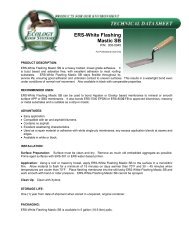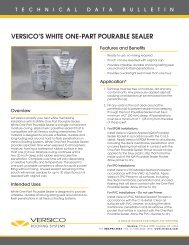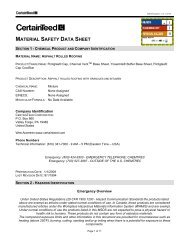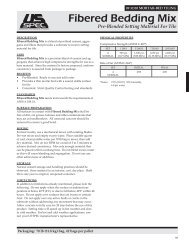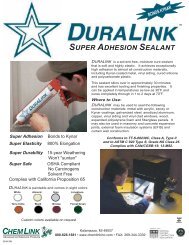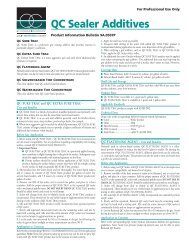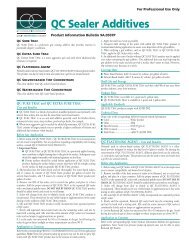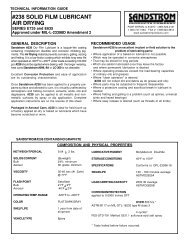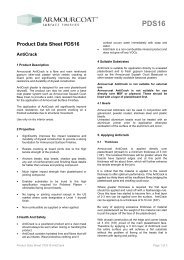Simpson Anchors - Anchoring and Fastening Systems - BuildSite.com
Simpson Anchors - Anchoring and Fastening Systems - BuildSite.com
Simpson Anchors - Anchoring and Fastening Systems - BuildSite.com
Create successful ePaper yourself
Turn your PDF publications into a flip-book with our unique Google optimized e-Paper software.
14<br />
SUPPLEMENTAL TOPICS FOR ANCHORS<br />
Prefabricated concrete is also referred to as "precast concrete". Precast<br />
concrete can be made at a prefabricating plant or site-cast in forms<br />
constructed on the job. Precast concrete members may be solid or may<br />
contain hollow cores. Many precast <strong>com</strong>ponents have thinner cross sections<br />
than cast in place concrete. Precast concrete may be either normal or<br />
lightweight concrete. Reinforced concrete contains steel bars, cable, wire<br />
mesh or r<strong>and</strong>om glass fi bers. The addition of reinforcing material enables<br />
concrete to resist tensile stresses which lead to cracking.<br />
The <strong>com</strong>pressive strength of concrete varies according to the proportions<br />
of the <strong>com</strong>ponents in the mixture. The desired <strong>com</strong>pressive strength of the<br />
concrete will be specifi ed according to the application. Water <strong>and</strong> cement<br />
content of the mix is the main determinant of the <strong>com</strong>pressive strength.<br />
The <strong>com</strong>pressive strength of concrete can range from 2,000 psi to over<br />
20,000 psi, depending on the mixture <strong>and</strong> how it is cured. Most concrete mixes<br />
are designed to obtain the desired properties within 28 days after being cast.<br />
Concrete Masonry Units (CMU) – Block is typically formed with large<br />
hollow cores. Block with a minimum 75% solid cross section is called solid<br />
block even though it contains hollow cores. In many parts of the country<br />
building codes require steel reinforcing bars to be placed in the hollow cores,<br />
<strong>and</strong> the cores to be fi lled solid with grout.<br />
In some areas of the eastern United States, past practice was to mix<br />
concrete with coal cinders to make cinder blocks. Although cinder blocks are<br />
no longer made, there are many existing buildings where they can be found.<br />
Cinder blocks require special attention as they soften with age.<br />
Brick – Clay brick is formed solid or with hollow cores. The use of either<br />
type will vary in different parts of the United States. Brick can be diffi cult<br />
to drill <strong>and</strong> anchor into. Most brick is hard <strong>and</strong> brittle. Old, red clay brick is<br />
often very soft <strong>and</strong> is easily over-drilled. Either of these situations can cause<br />
problems in drilling <strong>and</strong> anchoring. The most <strong>com</strong>mon use of brick today<br />
is for building facades (curtain wall or brick veneer) <strong>and</strong> not for structural<br />
applications. Brick facade is attached to the structure by the use of brick ties<br />
spaced at intervals throughout the wall. In older buildings, multiple widths, or<br />
“wythes” of solid brick were used to form the structural walls. Three <strong>and</strong> four<br />
wythe walls were <strong>com</strong>mon wall thicknesses.<br />
Clay Tile – Clay tile block is formed with hollow cores <strong>and</strong> narrow cavity<br />
wall cross sections. Clay tile is very brittle, making drilling diffi cult without<br />
breaking the block. Caution must be used in attempting to drill <strong>and</strong> fasten into<br />
clay tile.<br />
G2. Anchor failure modes<br />
Anchor Failure Modes<br />
The failure modes for both mechanical <strong>and</strong> adhesive anchors depends on<br />
a number of factors including the anchor type <strong>and</strong> geometry, anchor material<br />
mechanical properties, base material mechanical properties, loading type <strong>and</strong><br />
direction, edge distance, spacing <strong>and</strong> embedment depth.<br />
Six different failure modes are generally observed for mechanical <strong>and</strong> adhesive<br />
anchors installed in concrete under tension loading: concrete cone breakout,<br />
concrete edge breakout, concrete splitting, anchor slip, adhesive bond,<br />
<strong>and</strong> steel fracture. Three failure modes are generally observed for mechanical<br />
<strong>and</strong> adhesive anchors installed in concrete under shear loading: concrete edge<br />
breakout, pryout <strong>and</strong> steel failure.<br />
MECHANICAL ANCHORS<br />
M1. Pre-Load Relaxation<br />
Expansion anchors that have been set to the required installation torque<br />
in concrete will experience a reduction in pre-tension (due to torque) within<br />
several hours. This is known as pre-load relaxation. The high <strong>com</strong>pression<br />
stresses placed on the concrete cause it to deform which results in a<br />
Concrete Cone Breakout Failure<br />
This failure mode is observed for both mechanical <strong>and</strong> adhesive anchors installed<br />
at shallow embedment depths under tension loading. This failure mode<br />
is also observed for groups of mechanical <strong>and</strong> adhesive anchors installed at<br />
less than critical spacing.<br />
Concrete Edge Breakout Failure<br />
This failure mode is observed for both mechanical <strong>and</strong> adhesive anchors<br />
installed at less than critical edge distance under either tension or shear loading.<br />
For this failure mode neither the adhesive nor mechanical anchor fail, but<br />
rather the concrete fails. According to <strong>Simpson</strong> Strong-Tie testing, the tension<br />
load at which failure occurs is correlated to the concrete aggregate performance.<br />
Other factors may also infl uence tension load.<br />
Concrete Splitting Failure<br />
This failure mode is observed for both mechanical <strong>and</strong> adhesive anchors<br />
installed in a "thin" concrete member under tension loading.<br />
Anchor Slipping Failure<br />
This failure mode is observed for mechanical anchors under tension loading<br />
in which the anchor either pulls out of the member (e.g.- a Drop-In Anchor<br />
installed through metal deck <strong>and</strong> into a concrete fi ll) or the anchor body pulls<br />
through the expansion clip (e.g.- a Wedge-All ® anchor installed at a deep<br />
embedment depth in concrete).<br />
Adhesive Bond Failure<br />
This failure mode is observed for adhesive anchors under tension loading<br />
in which a shallow concrete cone breakout is observed along with an adhesive<br />
bond failure at the adhesive/base material interface. The concrete-cone breakout<br />
is not the primary failure mechanism.<br />
Steel Fracture<br />
This failure mode is observed for both mechanical <strong>and</strong> adhesive anchors under<br />
tension or shear loading where the concrete member thickness <strong>and</strong> mechanical<br />
properties along with the anchor embedment depth, edge distance, spacing, <strong>and</strong><br />
adhesive bond strength (as applicable), preclude base material failure.<br />
Pryout Failure<br />
This failure mode is observed for both mechanical <strong>and</strong> adhesive anchors<br />
installed at shallow embedment under shear loading.<br />
G3. Corrosion resistance<br />
Metal anchors <strong>and</strong> fasteners will corrode <strong>and</strong> may lose load-carrying<br />
capacity when installed in corrosive environments or exposed to corrosive<br />
materials. There are many environments <strong>and</strong> materials which may cause<br />
corrosion including ocean salt air, fi re-retardants, fumes, fertilizers,<br />
preservative-treated wood, dissimilar metals, <strong>and</strong> other corrosive elements.<br />
Some types of preservative-treated woods <strong>and</strong> fi re-retardant woods are<br />
known to be especially caustic to zinc <strong>and</strong> can cause anchors <strong>and</strong> fasteners to<br />
deteriorate. Zinc-coated anchors <strong>and</strong> fasteners should not be placed in contact<br />
with treated wood unless the treated wood is adequately verifi ed to be suitable<br />
for such contact. See page 16 in this catalog <strong>and</strong> contact the wood supplier for<br />
additional information.<br />
Some products are available with additional coating options or in stainless<br />
steel to provide additional corrosion resistance.<br />
Highly-hardened fasteners can experience premature failure due to<br />
hydrogen-assisted stress corrosion cracking when loaded in environments<br />
producing hydrogen. <strong>Simpson</strong> Strong-Tie ® re<strong>com</strong>mends that such fasteners<br />
be used in dry, interior <strong>and</strong> non-corrosive environments only.<br />
relaxation of the pre-tension force in the anchor. Tension in this context refers<br />
to the internal stresses induced in the anchor as a result of applied torque <strong>and</strong><br />
does not refer to anchor capacity. Historical data shows it is normal for the<br />
initial tension values to decrease by as much as 40–60% within the fi rst few<br />
hours after installation. Retorquing the anchor to the initial installation torque<br />
is not re<strong>com</strong>mended, or necessary.<br />
C-SAS-2009 © 2009 SIMPSON STRONG-TIE COMPANY INC.



